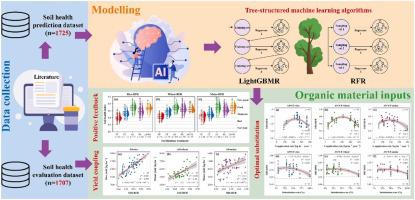Agriculture, Ecosystems & Environment ( IF 6.6 ) Pub Date : 2023-12-30 , DOI: 10.1016/j.agee.2023.108875 Chang Shi , Qingwen Zhang , Bowei Yu

|
Organic material input can improve soil health and mitigate adverse environmental consequences; however, there is controversy regarding the promoting effects of organic material inputs on soil health due to a lack of quantitative information on the effects of different organic materials from agricultural sources on soil health. This study proposed a novel soil health evaluation method using tree-structured machine learning algorithms to quantitatively assess the effects of animal-sourced (AS) and plant-sourced organic materials (PS) on soil health. The results demonstrated that in the testing set, the two ensemble models, random forest regressor (RFR) and light gradient boosting machine regressor (LightGBMR), showed high coefficient of determination () of 0.879 and 0.877, respectively, and relative percent deviation () of 2.83 and 2.84, respectively ( < 0.001). Our findings indicated that the application of AS resulted in superior improvement of soil health for rice, wheat, and maize in comparison to PS. Compared with chemical fertilizer (CF), AS improved soil health indices (SHIs) for rice, wheat, and maize by 23.8–39.8%, PS improved SHIs for rice, wheat, and maize by 13.4–24.4%, and AS + PS improved SHIs for rice, wheat, and maize by 16.0–35.4% ( < 0.001). In addition, the positive effect of AS on SHIs was greater than that of PS. Compared with PS, the SHIs for rice, wheat, and maize increased by 7.34–14.9% for AS ( < 0.001). The reasonable nitrogen (N) application rates for rice, wheat, and maize were 262–290, 235–259, and 299–331 kg ha−1 year−1, respectively. Based on the positive feedback effects on soil health, the reasonable AS substitution rates for rice, wheat, and maize were 26.4–29.2%, 27.0–29.8%, and 29.6–32.8%, respectively. This study confirmed that organic materials improve soil health through optimized substitution, thus contributing to sustainable agricultural management and reducing adverse environmental impacts.
中文翻译:

通过优化替代,动物源有机材料比植物源有机材料对土壤健康的改善更大
有机材料输入可以改善土壤健康并减轻不利的环境后果;然而,由于缺乏关于农业来源的不同有机材料对土壤健康影响的定量信息,关于有机材料投入对土壤健康的促进作用存在争议。本研究提出了一种新颖的土壤健康评估方法,利用树结构机器学习算法来定量评估动物源(AS)和植物源有机材料(PS)对土壤健康的影响。结果表明,在测试集中,随机森林回归器(RFR)和光梯度增强机回归器(LightGBMR)这两个集成模型表现出较高的决定系数()分别为 0.879 和 0.877,相对百分比偏差() 分别为 2.83 和 2.84 (< 0.001)。我们的研究结果表明,与 PS 相比,施用 AS 可以更好地改善水稻、小麦和玉米的土壤健康。与化肥(CF)相比,AS使水稻、小麦和玉米的土壤健康指数(SHI)提高了23.8%~39.8%,PS使水稻、小麦和玉米的土壤健康指数提高了13.4%~24.4%,AS+PS提高了土壤健康指数(SHI)。水稻、小麦和玉米的 SHI 提高 16.0–35.4%(< 0.001)。此外,AS对SHI的积极作用大于PS。与 PS 相比,AS 水稻、小麦和玉米的 SHI 增加了 7.34-14.9%(< 0.001)。水稻、小麦和玉米的合理施氮量分别为262-290、235-259和299-331 kg ha -1年-1 。基于对土壤健康的正反馈效应,水稻、小麦和玉米的合理AS替代率分别为26.4%~29.2%、27.0%~29.8%和29.6%~32.8%。这项研究证实,有机材料通过优化替代来改善土壤健康,从而有助于可持续农业管理并减少不利的环境影响。



























 京公网安备 11010802027423号
京公网安备 11010802027423号